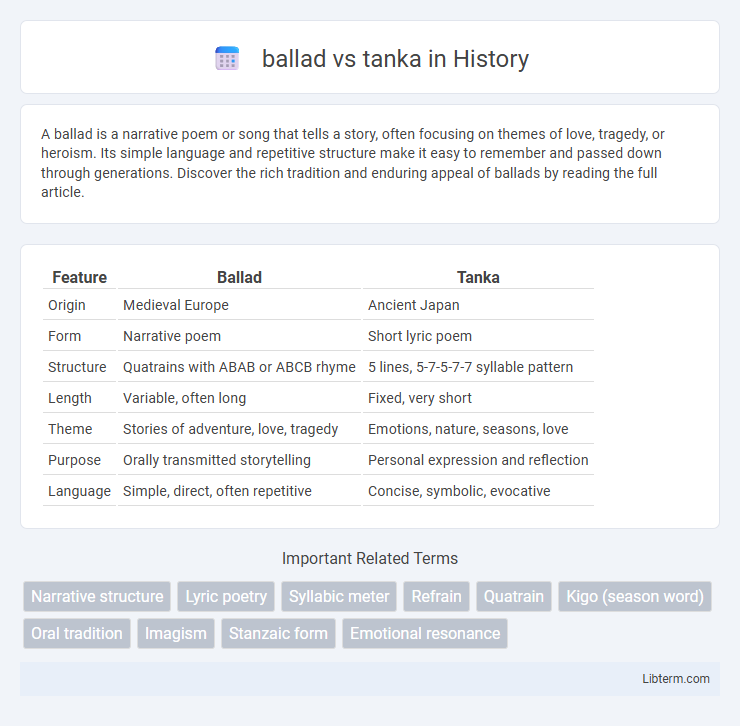A ballad is a narrative poem or song that tells a story, often focusing on themes of love, tragedy, or heroism. Its simple language and repetitive structure make it easy to remember and passed down through generations. Discover the rich tradition and enduring appeal of ballads by reading the full article.
Table of Comparison
| Feature | Ballad | Tanka |
|---|---|---|
| Origin | Medieval Europe | Ancient Japan |
| Form | Narrative poem | Short lyric poem |
| Structure | Quatrains with ABAB or ABCB rhyme | 5 lines, 5-7-5-7-7 syllable pattern |
| Length | Variable, often long | Fixed, very short |
| Theme | Stories of adventure, love, tragedy | Emotions, nature, seasons, love |
| Purpose | Orally transmitted storytelling | Personal expression and reflection |
| Language | Simple, direct, often repetitive | Concise, symbolic, evocative |
Introduction to Ballad and Tanka
Ballads are narrative poems traditionally composed in quatrains with a regular rhyme scheme, often telling stories of love, tragedy, or historical events through simple language and repetition. Tanka is a classical Japanese poetic form consisting of five lines with a 5-7-5-7-7 syllable pattern, emphasizing emotional expression and nature imagery within a concise structure. Both forms serve distinct cultural purposes, with ballads focusing on storytelling and tanka on evocative, lyrical reflection.
Historical Origins of Ballad and Tanka
The ballad originated in medieval Europe as a form of narrative poetry, often passed down orally to recount historical events, folklore, and romantic tales. In contrast, the tanka dates back over 1,300 years to ancient Japan's Heian period, characterized by a 31-syllable structure exploring personal emotions and nature. The ballad's evolving strophic form contrasts with the fixed syllabic pattern of the tanka, reflecting their distinct cultural and historical contexts.
Structural Differences: Ballad vs Tanka
Ballads typically consist of quatrains with an ABAB or ABCB rhyme scheme and a consistent meter, often iambic tetrameter, emphasizing narrative storytelling through repetitive refrains. Tanka is a classical Japanese poetic form with a strict 5-7-5-7-7 syllable structure, focusing on concise emotional expression without rhyme. Unlike ballads, tankas rely on syllabic count and imagery rather than rhyme or meter to create rhythm and meaning.
Thematic Focus in Ballad and Tanka
Ballads emphasize storytelling with themes of adventure, romance, tragedy, and heroism, often reflecting cultural history and folklore. Tanka centers on nature, seasons, emotions, and personal reflections, highlighting subtle imagery and mood within a concise structure. The thematic focus in ballads provides narrative depth, while tanka offers intimate emotional expression.
Language and Style Comparison
Ballads typically use simple, rhythmic language and repetitive structures to tell a narrative story, often featuring rhyme schemes like ABCB or ABAB, enhancing oral tradition and memorability. Tanka employs concise, free-flowing language within a strict 5-7-5-7-7 syllabic pattern, emphasizing emotional depth and vivid imagery rather than rhyme. The ballad's style prioritizes plot-driven storytelling, while the tanka focuses on introspective expression and subtle sensory details.
Cultural Significance of Ballad and Tanka
Ballads hold deep cultural significance in Western traditions, often serving as oral narratives that preserve historical events, legends, and communal values through lyrical storytelling. Tanka, rooted in Japanese culture, encapsulates emotional depth and seasonal imagery within a concise five-line structure, reflecting the aesthetics and spiritual sensitivity of Japanese poetry. Both forms function as cultural vessels, with ballads emphasizing collective memory and tanka highlighting personal expression intertwined with nature.
Notable Examples of Ballad and Tanka
Notable examples of ballads include "The Rime of the Ancient Mariner" by Samuel Taylor Coleridge and the traditional English folk ballad "Barbara Allen," both characterized by narrative storytelling and rhythmic repetition. In contrast, tanka examples such as "The Light of a Candle" by Ono no Komachi and "Winter Evening" by Yosano Akiko emphasize concise, emotionally evocative imagery within a 31-syllable, five-line structure. These works highlight the distinct cultural and structural qualities that define ballad and tanka poetry.
Impact on Modern Poetry
Ballads have shaped modern poetry through their narrative structure and rhythmic patterns, influencing contemporary storytelling techniques in verse. Tanka contributes by emphasizing brevity and emotional depth, inspiring concise, imagistic expressions in modern poetic forms. Both forms impact modern poetry by expanding thematic range and stylistic diversity.
Choosing Between Ballad and Tanka for Creative Writing
Ballads emphasize narrative storytelling through structured quatrains and a consistent rhyme scheme, making them ideal for dramatic or historical themes in creative writing. Tanka, consisting of five lines with a 5-7-5-7-7 syllabic pattern, excels at conveying concise emotions and vivid imagery, suited for introspective or nature-inspired pieces. Selecting between ballad and tanka depends on whether the writer prioritizes narrative depth or lyrical brevity in their artistic expression.
Conclusion: Ballad vs Tanka in Contemporary Literature
Ballads and tankas serve distinct roles in contemporary literature, with ballads emphasizing narrative storytelling through structured quatrains and refrains, while tankas concentrate on brief, emotive expression within a five-line, 31-syllable form. The ballad's oral tradition and rhythmic pattern make it ideal for conveying dramatic tales, whereas the tanka's concise and layered imagery suits introspective and nature themes. Writers often choose ballads for extended narratives and tankas for compact, poignant reflections enhancing modern poetic diversity.
ballad Infographic

 libterm.com
libterm.com